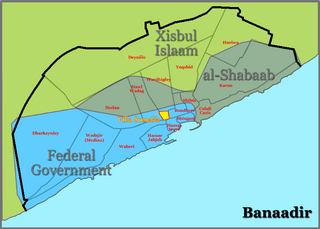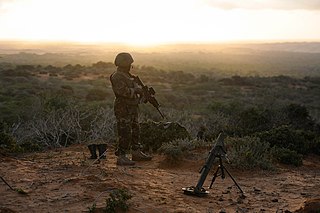
The Uganda People's Defence Force (UPDF), previously known as the National Resistance Army, is the armed forces of Uganda. From 2007 to 2011, the International Institute for Strategic Studies estimated the UPDF had a total strength of 40,000–45,000, consisting of land forces and an air wing. Recruitment to the forces is done annually.

Lower Shabelle is an administrative region (gobol) in southern Somalia.

The African Union Mission in Somalia (AMISOM) was a regional peacekeeping mission operated by the African Union with the approval of the United Nations Security Council. It was mandated to support transitional governmental structures, implement a national security plan, train the Somali security forces, and to assist in creating a secure environment for the delivery of humanitarian aid. As part of its duties, AMISOM supported the Federal Government of Somalia's forces in their battle against Al-Shabaab militants.

The Somali civil war (2009–present) is the ongoing phase of the Somali civil war which is concentrated in southern and central Somalia. It began in late January 2009 with the present conflict mainly between the forces of the Federal Government of Somalia assisted by African Union peacekeeping troops and al-Shabaab militants who pledged alliegence to al-Qaeda during 2012.

The Battle of Mogadishu (2009) started in May with an Islamist offensive, when rebels from al-Shabaab and Hizbul Islam attacked and captured government bases in the capital of Mogadishu. The fighting soon spread, causing hundreds of casualties, and continued on at various levels of intensity until October. The battle's name usually includes the year, when referenced, in order to distinguish it amongst the nine major Battles of Mogadishu during the decades long Somali Civil War.
Bulo Marer is a town in the southwestern Lower Shebelle region of Somalia. It was a base of Al-Shabaab, and was the site of an ill-fated 2013 military operation during which French commandos attempted to free a French hostage that was being held by the insurgent group. The town was taken by Somali government forces assisted by AMISOM troops after a battle on August 30, 2014. It was the site of the 2024 African Union base attack in Bulo Marer.

The Battle of Mogadishu (2010–11) began on 23 August 2010 when al-Shabaab insurgents began attacking government and African Union Mission to Somalia (AMISOM) positions in the Somali capital of Mogadishu. Al-Shabaab began its offensive after its spokesman said the group was declaring a "massive war" on troops sent by AMISOM, describing its 6,000 peacekeepers as "invaders". In December 2010 the number of AMISOM troops was increased to 8,000 and later to 9,000. The battle's name usually includes the years, when referenced, in order to distinguish it amongst the nine major Battles of Mogadishu during the decades long Somali Civil War.

This is a 2011 timeline of events in the Somali Civil War (2009–present).

This is a 2012 timeline of events in the Somali Civil War (2009–present).

This is a 2014 timeline of events in the Somali Civil War (2009–present).

Operation Indian Ocean was a joint military operation between the Somali military, AMISOM and the United States military against the Al-Shabaab militant group aimed at eliminating the remaining insurgent-held areas in southern Somalia. It officially began in August 2014.

This is a 2015 timeline of events in the Somali Civil War (2009–present).
Lego, is a town located in Bay, Somalia. It is situated 100 kilometres northwest of the capital Mogadishu and approximately 20 km west of Yaqbiriweyne and 54 km east of Burhakaba.
This article contains a timeline of events for the Somali jihadist group al-Shabaab.

This is a 2016 timeline of events in the Somali Civil War (2009–present).
On 1 April 2018, Al-Shabaab fighters attacked an AMISOM base in Bulo Marer in the Lower Shebelle region of Somalia.
Events in the year 2021 in Somalia.
On August 10, 2021, a patrol of Ugandan soldiers that formed part of the African Union Mission to Somalia (AMISOM) were ambushed and attacked in a farmland about 2½ kilometers from Golweyn by Al-Shabaab Islamic militants while on a routine patrol to secure the main supply route along the Beldamin-Golweyn Forward Operating Base in the Lower Shabelle.
This attack was followed by an exchange of gunfire between AMISOM forces and Al-Shabaab militants, that lasted several hours. "During the counterattack, 7 terrorists were killed while others sustained injuries and an assortment of weapons was recovered," AMISOM said in a tweet. Also one Ugandan soldier died. But afterwards, reports were received that the 7 deceased were not members of Al-Shabaab but civilians and that they had been killed by AMISOM forces, upon which the tweet was deleted. Abdulkadir Mohamed Nur, the Governor of Lower Shabelle confirmed after talking to local residents, that five farmers and two others whose vehicle broke down on the side of the road, were killed by the AMISOM soldiers after the ambush by al-Shabaab. District Commissioner Nur Osman Rage, detailed that after their encounter with Al-Shabaab, AMISOM forces "diverted to a nearby farm, picked an elderly farmer and four of his workers, blindfolded them and paraded them on the tarmac road. They then stopped two trucks on transit in the area, picked the two drivers, blindfolded them and together with the other five, took them to a point where an IED was planted, forced the civilians to sit on the device and detonated it on the seven victims who were blindfolded, instantly killing them.” The incident was allegedly witnessed firsthand by Somali security officers, local elders and many others in the area.
Events in the year 2023 in Somalia.
The battle of Buulo Mareer took place on 26 May 2023, when Al-Shabaab fighters stormed an African Union military camp manned by Ugandan forces in the town of Bulo Marer, Lower Shabelle, Somalia.











